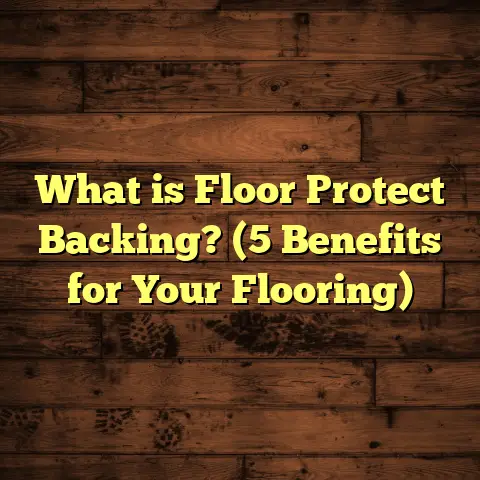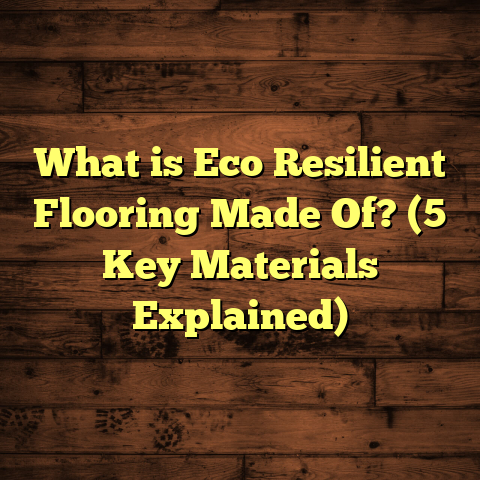What is Vinyl vs. Hybrid Flooring? (5 Key Differences Explained)
When I first got into flooring installations, I quickly realized that a “one-size-fits-all” approach doesn’t work. Each room in the house has unique demands. For example, your kitchen faces constant moisture spills and heavy foot traffic. Bathrooms deal with frequent humidity and water splashes. Living rooms and bedrooms prioritize comfort and appearance, while basements often grapple with dampness and uneven subfloors.
I’ve installed floors in all these spaces, and I’ve learned that picking the right type of floor can make or break how happy homeowners are later on. Some materials might look fantastic but won’t hold up well under certain conditions. Others might be durable but feel cold or uncomfortable underfoot.
That’s why when I talk about vinyl and hybrid flooring, I always start by asking: Where is this floor going? What will it face daily? How much wear and tear should it handle? These questions shape which product makes the most sense.
For instance, one of my clients had a tight budget but wanted a durable floor for her basement game room. After discussing moisture issues and comfort, I suggested vinyl plank flooring because it was waterproof and budget-friendly. Another client wanted a stylish living room floor that felt like real wood but was easier to maintain. Hybrid flooring fit the bill perfectly.
So before we jump into the details of vinyl versus hybrid, think about your space’s specific needs. That will help all the technical info make more sense.
What Is Vinyl Flooring?
Vinyl flooring is one of the oldest synthetic floor materials still going strong today. It’s made mostly from polyvinyl chloride (PVC), which is flexible and water-resistant. Vinyl comes in several forms:
- Sheets (large rolls laid down in one piece)
- Tiles (usually 12”x12” squares)
- Planks (longer strips resembling hardwood boards)
From my experience, vinyl plank flooring has become the most popular choice because it combines ease of installation with a natural wood or stone look. Thickness usually ranges from 2 mm (thin budget options) up to 8 mm for premium lines.
Vinyl planks typically measure around 6 to 9 inches wide and 36 to 48 inches long. This size range allows manufacturers to mimic hardwood dimensions closely.
Materials cost varies widely depending on quality. Basic vinyl plank flooring can cost as little as $1.50 per square foot, while high-end options with thick wear layers and embossed textures run $4 to $6 per square foot.
Labor for installation typically adds $1 to $3 per square foot, depending on complexity and location. A simple kitchen floor of approximately 200 square feet might cost around $1,000 total—materials plus installation.
Vinyl is famous for being waterproof or at least water-resistant. That makes it ideal for bathrooms, kitchens, mudrooms, and basements where spills or humidity are frequent.
I remember installing vinyl floors for a client in Seattle who had a toddler and a dog. They needed something that could withstand water spills, scratches from paws, and easy clean-up. Vinyl was perfect — it looked good for years and cleaned up with just a damp mop.
One drawback is that lower-end vinyl can feel a little thin or hollow underfoot compared to real wood or tile. However, many manufacturers add foam or cork backing layers to improve comfort.
What Is Hybrid Flooring?
Hybrid flooring is relatively new but growing fast in popularity because it blends the best qualities of vinyl and rigid core materials like laminate or engineered wood.
The main feature is its multi-layer construction:
- Rigid Core: Usually made from limestone composite (SPC) or wood plastic composite (WPC). SPC is denser and more durable; WPC offers better comfort.
- Vinyl Wear Layer: A vinyl top layer that protects against scratches, stains, and moisture.
- Decorative Layer: High-resolution photographic film that mimics wood grain or stone textures.
- Backing Layer: Provides stability and sound absorption.
Hybrid planks tend to be thicker than standard vinyl — usually between 6 mm and 8 mm thick — making them feel sturdier underfoot.
Their dimensions are similar to vinyl planks: around 7 to 9 inches wide and 48 inches long.
Because of their construction, hybrid floors are more dimensionally stable than laminate and more durable than basic vinyl. That means they resist warping, swelling, and dents better than many alternatives.
From my own projects, hybrid floors work great in living rooms, hallways, and even basements where moisture and foot traffic are concerns.
For example, last year I installed hybrid flooring in a family’s basement in Atlanta (about 350 sq ft). The material cost was around $4 per square foot, with installation adding $2 per square foot. The whole project took just three days because the planks click together easily.
The family loved how realistic the wood-look planks appeared — complete with embossed textures that felt like natural oak underfoot.
A nice bonus: hybrid floors don’t require glue or nails; their click-lock system makes future repairs simpler.
5 Key Differences Between Vinyl and Hybrid Flooring
1. Composition and Structure
Vinyl flooring consists mainly of several layers of PVC with protective wear layers on top. It’s flexible but can be thin depending on the product grade.
Hybrid flooring has a solid core made from limestone composite (SPC) or wood plastic composite (WPC), topped with vinyl on the surface. This core gives hybrid floors their rigidity and strength.
I once had a client in Florida who installed mid-grade vinyl flooring in a sunroom only to find the planks buckling after a few months due to heat and humidity changes. Hybrid flooring would have handled those temperature swings better thanks to its rigid core.
2. Water Resistance
Both vinyl and hybrid floors are highly water-resistant compared to hardwood or laminate.
Vinyl is usually fully waterproof due to its PVC makeup; some sheet vinyl options even create a continuous water barrier.
Hybrid floors are also waterproof but can provide better resistance to standing water because their rigid core doesn’t swell or deform easily.
In wet basements I’ve worked on in Chicago and New Orleans, hybrid floors performed exceptionally well after flooding events — no warping or lifting like some older vinyl floors showed.
3. Installation Process
Vinyl installation methods vary:
- Glue-down: Requires adhesive applied to subfloor.
- Peel-and-stick: Self-adhesive backing for quick installs.
- Floating: Some vinyl planks click together without glue.
Hybrid floors almost always use click-lock floating systems that snap planks together over an underlayment.
From my experience, vinyl peel-and-stick is great for small DIY projects but less durable long-term. Hybrid’s locking system speeds up professional installs but demands very flat subfloors (within 1/8 inch variance).
I once installed peel-and-stick vinyl in a small bathroom over two days myself, but for a large living room hybrid project (500 sq ft), it took a crew three days due to necessary subfloor prep and acclimation time.
4. Durability and Wear
Wear layers protect floors from scratches, dents, and stains:
- Standard vinyl wear layers range from around 12 mils (light residential use) up to 30 mils (commercial grade).
- Hybrid wear layers are typically thicker — 20 mils or more — making them tougher against heavy traffic.
In retail spaces I’ve serviced, hybrid floors held up better under constant foot traffic than basic vinyl planks which showed scuffing within months.
If you have pets or kids who drag toys across floors, hybrid flooring tends to resist damage better while maintaining its finish longer.
5. Cost Differences
Budget plays a big role in choosing between these two flooring types:
- Vinyl materials generally cost between $2 to $5 per square foot.
- Installation adds roughly $1 to $3 per square foot.
- Hybrid materials cost about $3.50 to $6 per square foot.
- Installation can be $2 to $4 per square foot due to prepping requirements and acclimation time.
For example, I priced out replacing flooring in a standard 250-square-foot kitchen:
- Vinyl option came out around $1,000 total.
- Hybrid option was closer to $1,500 due to higher material costs and longer install time.
While hybrid costs more upfront, its durability often means fewer repairs or replacements over time — saving money down the road.
My Personal Take: When Would I Choose Vinyl? When Hybrid?
In my line of work, I’ve seen both materials shine when matched properly with room use.
I often recommend vinyl flooring for:
- Bathrooms
- Laundry rooms
- Kitchens
- Budget-conscious projects
- Areas with uneven subfloors where flexible material helps
A client in Boston chose vinyl for her condo kitchen remodel because it was affordable, waterproof, and easy to clean after cooking spills from her busy household of four.
On the flip side, I suggest hybrid flooring when:
- You want wood or stone visuals that feel authentic
- Rooms have heavy traffic like living rooms or hallways
- Moisture resistance is still important (basements)
- You want longer-lasting resilience worth paying more for
In Seattle, I worked with a family who had two dogs and wanted a stylish living room floor that could handle muddy paws without scratching easily — they picked hybrid flooring for its combination of beauty and strength.
Data-Backed Insights From Research
Looking at industry research supports what I’ve seen firsthand:
- The National Wood Flooring Association found hybrid flooring lifespan exceeds 20 years under normal home conditions.
- Vinyl commonly lasts around 10–15 years but depends heavily on quality.
- HomeAdvisor reports average total costs per square foot as follows:
- Vinyl: $3–7 including labor
- Hybrid: $5–10 including labor
- A study from a Chicago property management company showed hybrid floors reduced tenant repair calls related to flooring by 30% compared to older vinyl surfaces over five years.
- According to FloorScore certifications (indoor air quality), both vinyl and hybrid products meet strict VOC emission standards — important if you’re sensitive to chemicals indoors.
Case Studies From My Projects
Case Study #1: Vinyl Flooring in a Boston Condo
A young family wanted an affordable kitchen upgrade that wouldn’t break the bank but needed durability against spills and kids’ messes. We chose mid-grade luxury vinyl planks with a 20 mil wear layer.
Installation took two days over a clean plywood subfloor with minor leveling needed. The family reported back after one year that the floor was still looking brand new despite heavy use. Cleanup remained easy with just mild detergent mopping weekly.
Case Study #2: Hybrid Flooring in an Atlanta Basement
This client wanted something waterproof yet stylish for their basement rec room where humidity was an issue. We installed SPC-based hybrid planks with an embossed oak finish.
The project took three days including acclimation time before installation. Two years later, no signs of warping or damage even after occasional flooding events from heavy rains outside.
The family loved how comfortable the floor felt compared to their old concrete slab and noted it stayed warmer during winter months too.
Installation Tips From My Experience
Whether you pick vinyl or hybrid flooring, these tips can save you headaches:
- Subfloor Prep Matters: Uneven subfloors cause clicking problems in hybrids or adhesive failures in vinyl.
- Acclimation: Hybrid floors generally need at least 48 hours indoors before installation so they adjust to temperature/humidity.
- Use Proper Underlayments: Especially for hybrids, this reduces noise and adds comfort.
- Follow Manufacturer Guidelines: Especially for moisture barriers in basements or concrete slabs.
- Don’t Rush Installation: Quality takes time — rushing leads to gaps or uneven surfaces.
Maintenance & Care Tips
Vinyl floors are low maintenance — regular sweeping/mopping keeps them clean. Avoid harsh chemicals or abrasive tools that can damage the wear layer.
Hybrid floors need gentle cleaning solutions designed for resilient floors. Wax or oil-based cleaners can cause build-up or dull finishes.
Both types benefit from felt pads under furniture legs to prevent scratches.
Repairs differ too: You can replace individual vinyl tiles easily; hybrids may require removing multiple planks depending on damage extent.
Environmental & Health Considerations
Some people worry about synthetic floors releasing chemicals indoors. Both vinyl and hybrid products have improved significantly here:
Many brands now offer FloorScore-certified options that meet strict indoor air quality standards limiting VOC emissions.
Hybrid’s rigid core often contains limestone composites rather than wood particles reducing mold risks in damp areas.
Proper installation with moisture barriers prevents mold growth underneath both floor types.
For eco-conscious buyers, some manufacturers recycle old vinyl into new products; others use sustainable manufacturing processes for hybrids.
Comparing Aesthetics: Which Looks Better?
Vinyl has come a long way from plain sheets of plastic. High-quality vinyl planks now feature embossed textures that mimic wood grains realistically. However, some cheaper vinyl looks flat or artificial up close.
Hybrid flooring excels at reproducing natural wood or stone surfaces with multi-layer embossing techniques creating depth you can see and feel.
If appearance is your top priority—especially if you want hardwood visuals without hardwood price—hybrid floors usually win out by offering richer textures.
Regional Cost Variations & Timeframes
Costs vary significantly by region due to labor rates and material availability:
- In urban areas like New York City or San Francisco, expect labor costs closer to $3-$4 per sq ft.
- Rural areas might see labor as low as $1-$2 per sq ft.
- Material shipping fees also affect pricing for exotic finishes.
Typical installation times:
| Project Size | Vinyl Installation Time | Hybrid Installation Time |
|---|---|---|
| Small Bathroom (50 sq ft) | 1 day | 1–2 days |
| Average Kitchen (200 sq ft) | 1–2 days | 2–3 days |
| Large Living Room (400+ sq ft) | 2–3 days | 3–4 days |
Planning accordingly prevents rushing jobs which impact quality.
Final Thoughts: Making Your Choice
Choosing between vinyl and hybrid flooring boils down to your room’s demands, budget constraints, aesthetic preferences, and long-term goals.
Vinyl offers affordability, waterproof protection, simple installation, and easy maintenance—great for utility spaces or budget projects.
Hybrid flooring brings durability, realistic looks, comfort underfoot, and excellent moisture resistance—ideal for main living areas where style meets function.
I recommend measuring your space carefully (including closets/pantries), factoring in prep work time (usually 1–3 days), and getting multiple local quotes based on current labor rates near you using tools like FloorTally for accuracy.
If you want help deciding which fits your home best based on your specific rooms and lifestyle habits—just ask! I’m happy to help figure out what works best so you get floors you love living on every day.
Have you tried either type of flooring? What was your experience like? Feel free to tell me about your project—I’d love to share tips tailored exactly for your situation!





